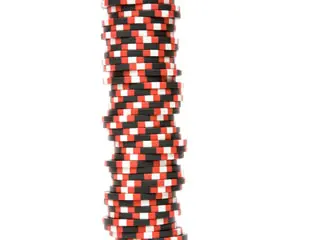

We're always looking for ways that we can force our opponents to make mistakes in poker. The more difficult spots we can force our opponents into, the more likely it is that we can gain equity against them as a hand progresses. The double negative effect doesn't come into play until later in the hand, usually a couple bets after the “setup play” is made. Usually this is because your opponent has become predictable in some manner and a relatively small change in how you deal with them will lead to a somewhat predictable set of future plays by them. It is possible, to force an opponent into a particularly nasty scenario; a line that encourages our opponent to make a play later that, no matter the outcome (given their likely range), will have negative effects based on your hand and his hand. An opponent with a middling hand can be forced to either check/fold to a big bet on the river or bet and fold to your big raise, based on the way you played the hand, and both plays can be wrong; you could have air, and because you've trapped your opponent into taking a passive line earlier in the hand, will win the pot whether he checks or bets the river when you raise. This is a double negative effect situation, and though it sounds like a difficult concept to accomplish, by learning how to condition opponents to reacting to your play, you can force your opponents into incredibly awkward scenarios by simply moving up and down in your level of thinking before they can react.
A lot of these double negative scenarios come up short handed, when player predictability increases and the amount of hands you play solely against a player increases. By ramping up the frequency you interact with a player, patterns become prevalent, ones in which you can look to exploit tendencies that they exhibit. We'll take the final table of a $27 tournament on Stars that one of our coaches, (due to the revealing nature of this article about his play, he has asked to be kept anonymous) we will call him “Poker Coach”, won recently. When play got to 3 handed, he found himself deep stacked against a incredibly deep stacked player and a very short stack. We'll label the big stack as Player A and the short stack as Player B. The first few hands of 3 handed we're simple; button raised/shoved, everyone folds, next hand. Finally, when Player A opened for 2.5x to t5,000 on the third orbit, Poker Coach repopped it to 12,000 from the small blind. Both player quickly folded, and Poker Coach had established that every open would not be taken with a walk from that point on. The short stack quickly jumped on the 3 bet bandwagon, repopping all-in a few times when Poker Coach or player A opened, chipping up slightly. A few hands later, Player A opened for t5,000, Poker Coach repopped to t13,000, the big blind flatted the t13,000, and Player A made it t50,000, covering the big blind and accounting for 20% of Poker Coach's chips. He folded, the big blind snapped off with JJ and ultimately fell to Player A's A6s. An interesting dynamic has just been discovered about Player A's game; he's already grown frustrated with Poker Coach's 3 betting and had decided to begin 4 betting lighter than he had previously. Poker Coach made a note of this as the heads up battle began, with stacks as follows.
Blinds t1,250/t2,500/(t250) (t4,250/round)
Poker Coach- t230,000 (M54)
Player A- t400,000 (M94)
With this much play between stacks, Poker Coach knew that he had the time to set up his opponent, who has shown a tendency to get annoyed easily at constant aggression, into making a critical error later on in the tournament. As such, he began to alter his game against Player A for a short time, doing the following things differently after the first 20 hands of the heads-up part.
Opening 100% of buttons for a min-raise. This allowed for a omnipresent aggression factor to begin weighing on his opponent; the min itself was irrelevant of the hand itself. Because his opponent showed a willingness to fold to the mini-raise a fair amount of the time (After 20 hands, he folded to the mini raise 3/10) the mini became immediately profitable.
3 betting Player A with the top 80% of hands for a small amount. His opponent did, so far in the tournament, two things when faced with the small 3-bet; folded or made a large 4-bet. He never chose to flat the 3-bet, which helped Poker Coach streamline his play against him.
4-betting when he was re-raised a VERY SMALL amount, instead flatting a large majority of the time. He was able to play inflated pots with position against an opponent that had zero clue what he was opening with, since the min-raise was completely automatic.
Let's look at a few hands that the two played that piqued my interest, based on having access to Poker Coach's hole cards.
Poker Coach (78d)
Player A (??)
Poker Coach- Raises to 5k
Player A- 3-bets to 15k
Poker Coach- 4-bets to 32k
Player A- Calls
Flop- Ad9h7c
Player A- Checks
Poker Coach- Bets 24k
Player A- Folds
This hand revealed something pretty interesting in the dynamic of the match that Poker Coach was able to utilize later on in one of the “double negative” decisions his opponent faced. Poker Coach 4 bet light and small, and his opponent flatted out of position, then check/folded an ace high flop for a one-third pot bet. This means that our opponent is 3 betting us a bit lighter than we suspected, since 1010-KK and any ace are going to almost always either 5-bet us preflop or call our flop bet. So, his 3 bet range can now include any pocket pair, KQ/KJ/K10, a lot of weaker stuff than we originally gave him credit for 3 betting us with, as we had perceived him to be tight.
Ten hands later, the stacks looked like this.
Blinds t1,500/t3,000/(t300) (t5,100/round)
Poker Coach- t280,000 (~M56)
Player A- t350,000 (~M70)
And once again, Poker Coach got a chance to 4-bet.
Poker Coach-(23h)
Player B-(A7o)
Poker Coach- Raises to 6k
Player A- 3-Bets to 18k
Poker Coach- 4-Bets to 38k
Player A- Calls
Once again, Poker Coach has put his opponent in awkward spot, calling 12 BB's out of position and signaling to his opponent that he doesn't have a monster hand. 23 even suited is a pretty terrible hand particularly heads up. This is a somewhat advanced tempo play, after discussing with him, in this spot he was 4 betting all strong hands, and roughly one-in-three times any two cards. For the sake of staying on topic, lets give him credit for this seemingly marginal raise, and get back to the hand.
Flop- 2c 2s 5h
Player A-Bets 25k
Poker Poker Coach- Calls
Do you see what's now happened? Poker Coach obviously didn't know Player B's hole cards, but after getting forced out of the last hand with a small bet, he elected to do the same thing in this hand, screaming to Poker Coach that, “Hey, that play worked really well for you last time, I'm going to take the lead from you and try it myself here.” The problem is, he's bluffing into the guy that has been calling, raising, and doing anything BUT folding in spots like this, and Poker Coach's call can be an incredibly wide range of hands; 34o, 36o, A10o, 33, KK, almost anything. A7 just looks so bad here, but thanks to Poker Coach's seemingly reckless play from before, he's encouraged his opponent to bluff so Poker Coach doesn't have to try to extract money from him.
Turn- 2c2s5h 7c
The turn is the ugliest card in the deck for our opponent, as it now puts him in the “double negative” spot that we were talking about. Even though he made top pair, top kicker on the turn, what range of hands that Poker Coach holds here will call a bet? The open-ended draw? Maybe. The 5? Maybe. But a lot of the ugly draws go away here, so he doesn't get a lot of value from hands that he beats. Meanwhile, if Player A checks and Poker Coach bets, is he calling? There's already 126k in the pot, and Poker Coach only has 217k left. So, a bet from Poker Coach of 50-80k means that you may be looking at a big bet on the river of Poker Coach's whole stack. Is a 7 good enough here? So, our opponent has two lines he can take here, realistically.
Bet out 50k-80k. It looks pretty strong, after leading the flop, which can discourage Poker Coach from playing the draws and the “floating” style hands that he may have here. But, what do we do when Poker Coach continues playing, or worse, shoves? If he calls, we're really locked into checking the river, unless a 7 hits, because of the wild range that Poker Coach has, combined with any number of scare cards that can hit; 8-K, a club, a 6, even the ace. Our hand looks good now, but probably not on the river.
Check. We can check here, and fully expect Poker Coach to take the lead in the hand almost every time. What do we do with A7 here when Poker Coach bets out 90k? Or 50k? We have a hand that rates to be good now, but if we shove, what's he calling us with? The 2 and overpairs, almost always, worse 7's, yes, draws, probably not. So, if we check/shove, we're getting it in horrible sometimes and winning occassionally.
So, no matter what we do on the turn, Poker Coach ends up getting control in the hand. He can bluff, he can get value, he's in control, no matter the hand.
Player A- Bets 40k
Poker Coach- Raises to 85k
And once again, Poker Coach opens the door for Player A to make a huge mistake again. He leaves himself 132k behind the dink raise, which makes it look like he can still fold if he's raised here. If Poker Coach had just shoved, Player A may realize that he's committed to the hand and be able to release the A7. But because of how Poker Coach has been playing prior…
Player A- 3-Bets All-In (217k)
Poker Coach- Calls
River- 2c2s5h7c 10c
Poker Coach- Wins Pot (560k)
Putting opponents in a position to make a mistake, no matter their move in the hand, is the easiest way to win tournaments in the late stage. Look for opportunities to condition your opponents into a play style, and the double negative scenario will make itself apparent a lot more often.
All contents are ©
Bet365 Bonus Code, Sports, Casino and Poker Sign up offers and News
18+ Worried about your gambling?
Gamcare - When the fun stops – STOP!